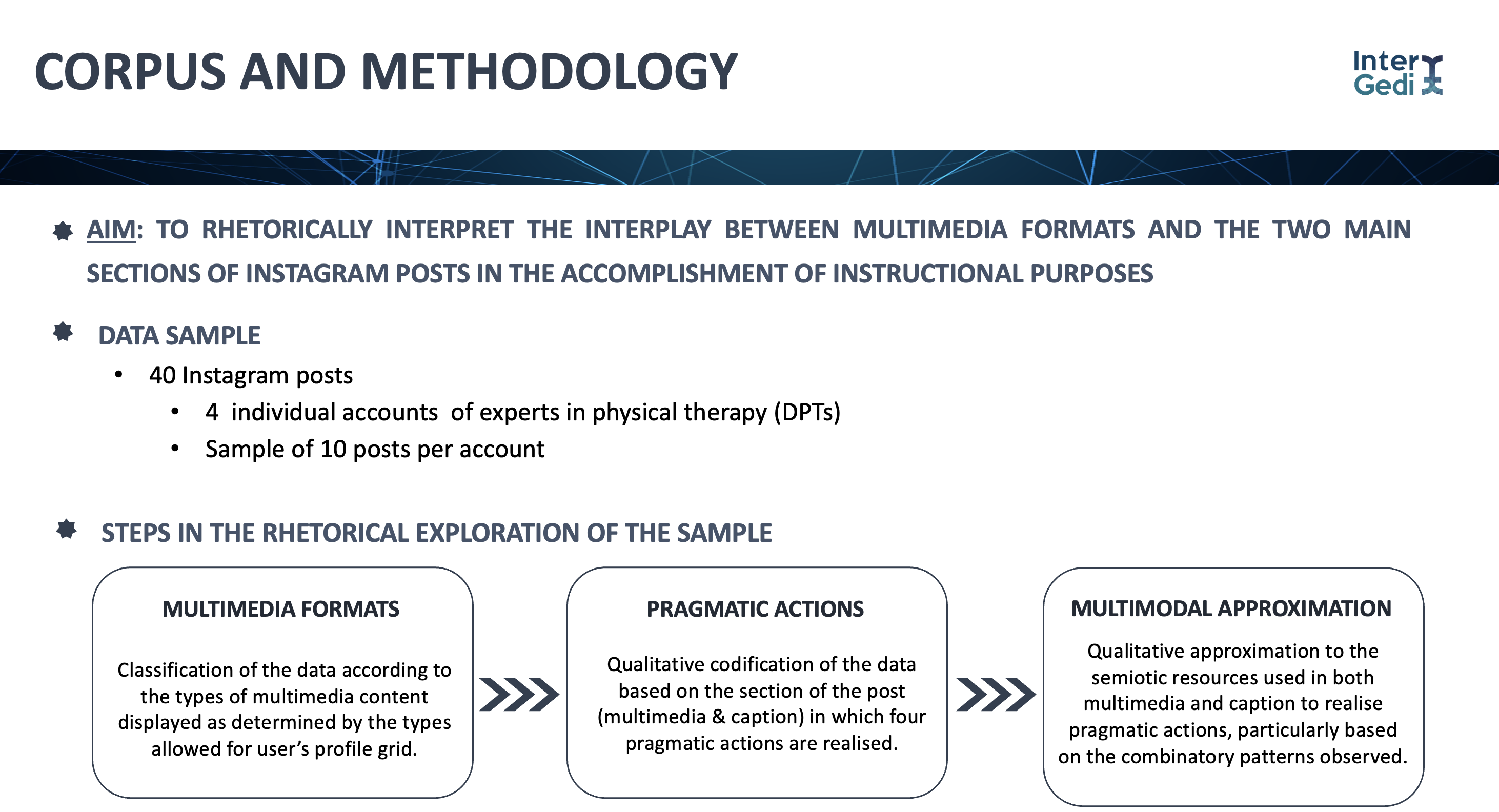AELFE 2025: ANA SANCHO-ORTIZ LOOKS INTO INSTRUCTION ON INSTAGRAM POSTS FROM A MULTIMODAL LENS

Together with other InterGedi members, our PhD candidate Ana E. Sancho-Ortiz gave a presentation at the AELFE Conference organised by the GRAPE research group and held at Universitat Jaume I. This XXIII edition of the international congress took place in late June 2025, starting on Wednesday 25th and ending on Friday 27th.
The paper she delivered, as its title suggests, “Leveraging Instagram affordances for science dissemination: A social semiotic multimodal approach to instruction on Instagram posts for physical therapy”, was aimed at exploring how discipline-specific practical information was disseminated by exploiting the different multimodal affordances that Instagram posts offer.
You can find her abstract below:
Leveraging Instagram affordances for science dissemination: A social semiotic multimodal approach to instruction on Instagram posts for physical therapy
The rapid development of digital platforms has provided the scientific community with opportunities to promote the democratisation of knowledge by rendering it accessible to diversified audiences (Engberg, 2023). This not only involves the transmission of theoretical concepts but also the communication of discipline-specific practical knowledge. Within the diverse range of digital media available today, social media emerge as channels whose accessible technological affordances (Seargeant & Tagg, 2014) facilitate the production of user-generated content (Boyd & Ellison, 2007; Santos, 2022), thereby enhancing the recontextualisation of specialised knowledge into a multiplicity of forms. This contribution examines instruction as a dissemination practice focused on the transmission of practical knowledge, increasingly present in scientific communication on social media. To this end, it adopts a social semiotic approach to multimodally analyse 40 Instagram posts from four expert users in physical therapy (10 posts each). This paper explores how expert users leverage Instagram’s multimedia affordances to create combinations of multimedia formats through which instructional content can be delivered. Drawing on Kress & van Leeuwen’s (2020) visual grammar and conceptualising Instagram posts as cohesive units of meaning, this research considers the interaction between multimedia formats and post captions as central to achieving instructional purposes. A rhetorical analysis is thus conducted of the existing multimedia-caption layout combinations and the semiotic realisations of instructional cues associated with each of them. Preliminary results point to video-based caption-multimedia clusters as the preferred format among physiotherapy experts to share practical knowledge. A tendency is observed within these to rely on physical embodied resources as explanatory markers, emphasising the role of experts as information providers. Similarly, physical embodied resources seem to be strategically combined with verbal and visual features (namely, imperatives, deictic pronouns, and arrow-like graphical icons) to signal transitions between exercises, thereby facilitating the comprehensibility and replicability of the practical knowledge shared.
References
Boyd, D., & Ellison, N. B. (2007). Social Network Sites: Definition, History, and Scholarship. Journal of Computer-mediated Communication, 13(1), 210–230. https://doi.org/10.1111/j.1083-6101.2007.00393.x
Engberg, J. (2023). Between infotainment and citizen science: Degrees of intended non-expert participation through knowledge communication. In R. Plo-Alastrué & I. Corona (Eds.), Digital scientific communication: Identity and visibility in research dissemination (pp. 149-170). Palgrave Macmillan. https://doi.org10.1007/978-3-031-38207-9_7
Kress, G., & Van Leeuwen, T. ([1996, 2006] 2020). Reading images: The grammar of visual design (3rd ed.). Routledge. https://doi.org/10.4324/9781003099857
Santos, M. L. B. D. (2022). The “so-called” UGC: an updated definition of user-generated content in the age of social media. Online Information Review, 46(1), 95-113. https://doi.org/10.1108/OIR-06-2020-0258
Seargeant, P., & Caroline T. (2014). The language of social media: Identity and community on the internet. Palgrave Macmillan.
